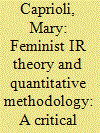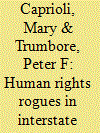|
|
|
Sort Order |
|
|
|
Items / Page
|
|
|
|
|
|
|
| Srl | Item |
| 1 |
ID:
058800


|
|
|
| 2 |
ID:
057588


|
|
|
| 3 |
ID:
065802


|
|
|
| 4 |
ID:
085679


|
|
|
|
|
| Publication |
2009.
|
| Summary/Abstract |
Does the security of women influence the security and behavior of states? Existing evidence linking the situation of women to state-level variables such as economic prosperity and growth, health, and corruption is fairly conclusive. Questions remain, however, concerning the degree to which state security and state security-related behavior is linked to the security of women. The "women and peace" thesis draws upon evolutionary biology/psychology for ultimate causes of this linkage, and sociological theories of social diffusion and psychological theories of social learning for more proximate causal mechanisms. Together, a new data resource-the WomanStats Database-and conventional methodology find a robust, positive relationship between the physical security of women and three measures of state security and peacefulness. In addition, a comparison of this proposition to alternative explanations involving level of democracy, level of economic development, and civilizational identity shows that the physical security of women is a better predictor of state security and peacefulness. Although these results are preliminary, it is still possible to conclude that the security of women must not be overlooked in the study of state security, especially given that the research questions to be raised and the policy initiatives to be considered in the promotion of security will differ markedly if the security of women is seriously considered as a significant influence on state security.
|
|
|
|
|
|
|
|
|
|
|
|
|
|
|
|
| 5 |
ID:
068743


|
|
|
| 6 |
ID:
081310


|
|
|
|
|
| Publication |
2008.
|
| Summary/Abstract |
Regardless of the primary motive, international military intervention aimed at nation building is partly intended to establish democratic societies. And scholars have demonstrated that intervention does have a positive impact on democratization. With democratization generally follows greater support for human rights. Feminist scholars, however, have questioned definitions of democracy in which at minimal, women's political rights are absent. This brings into question the impact of intervention on the status of women. Particularly in both Iraq and Afghanistan women's rights have become prominent in the post-invasion American political rhetoric. Since intervention seems to be associated with the spread of democratic principles, we seek to discover whether intervention actually moves societies toward gender equality. We examine all six cases of completed military intervention aimed at nation building in sovereign states during the post Cold War period. Three of the cases-El Salvador, Mozambique, Namibia-evidence democratic change; whereas, the remaining three states-Cambodia, Haiti, Somalia-remain undemocratized. We test the extent to which intervention has or has not improved women's equality and find no dramatic effect, either positive or negative, of intervention on the status of women in any of the six states
|
|
|
|
|
|
|
|
|
|
|
|
|
|
|
|
| 7 |
ID:
066291


|
|
|
| 8 |
ID:
093093


|
|
|
|
|
| Publication |
2009.
|
| Summary/Abstract |
This article describes the WomanStats Project Database - a multidisciplinary creation of a central repository for cross-national data and information on women available for use by academics, policy-makers, journalists, and all others. WomanStats is freely accessible online, thus facilitating worldwide scholarship on issues with gendered aspects. WomanStats contains over 260 variables for 174 countries and their attendant subnational divisions (where such information is available) and currently contains over 68,000 individual data points. WomanStats provides nuanced data on the situation and status of women internationally and in so doing facilitates the current trend to disaggregate analyses. This article introduces the dataset, which is now publicly available, describes its creation, discusses its utility, and uses measures of association and mapping to draw attention to theoretically interesting patterns concerning the various dimensions of women's inequality that are worthy of further exploration. Two of nine variables clusters are introduced - women's physical security and son preference/sex ratio. The authors confirm the multidimensionality of women's status and show that the impact of democracy and state wealth vary based on the type of violence against women. Overall, the authors find a high level of violence against women worldwide.
|
|
|
|
|
|
|
|
|
|
|
|
|
|
|
|
|
|
|
|
|